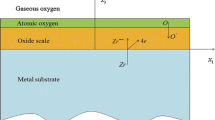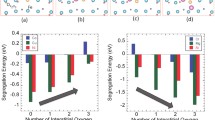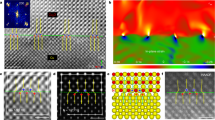Abstract
Recent studies of the structure and dynamics of solid-solid interfaces have provided some understanding about the role of the scale-metal interface in the growth of reaction product scales on pure metals. The action of interfacial defects (misfit dislocations, misorientation dislocations and disconnections) in the creation and annihilation of the point defects suporting the diffusional growth of scales is considered. Anion point defects (vacancies/interstitials) supporting scale growth by anion diffusion are annihilated/created by the climb of misorientation dislocations or disconnections in the scale at the interface. For scale growth by cation diffusion, cation point defects (vacancies/interstitials) can be annihilated/created by the climb of interfacial misfit or misorientation dislocations in the metal. Because of their necessarily high density, in most cases, the dominant climb of misfit dislocations would be favored. The blocking of interfacial reaction steps can be a means to retard the scaling kinetics and to alter the fundamental scaling mode. For instance, the interfacial segregation of large reactive element ions can pin the interface dislocations, an action which poisons the usual interfacial reaction step. Such considerations are consistent with the well-known phenomena ascribed to the reactive element effect (REE).
Similar content being viewed by others
References
C. Wagner, inAtom Movements (American Society of Metals, Metals Park, 1951), p. 153.
D. Vermilyea,Acta Metall. 5, 492 (1957).
B. Pieraggi and R. A. Rapp,J. Electrochem. Soc. 140, 2844 (1993).
W. A. Tiller,J. Electrochem. Soc. 127, 625 (1980);128, 689 (1981).
B. E. Deal and A. S. Groves,J. Appl. Phys. 36, 3770 (1965).
J. P. Hirth and W. A. Tiller,J. Appl. Phys. 56, 947 (1984).
B. Pieraggi and R. A. Rapp,Acta Metall. 36, 1281 (1988).
B. Pieraggi, R. A. Rapp, F. J. J. VanLoo and J. P. Hirth,Acta Metall. Mater. 38, 1781 (1981).
J. P. Hirth,Metall. Trans. 22A, 1331 (1991).
A. Strawbridge and R. A. Rapp,J. Electrochem. Soc. 141, 1905 (1994).
J. J. Conzales, D. Oquab and B. Pieraggi, Proc. Krakow Conf. on High Temperature Corrosion, 1994.
J. P. Hirth, B. Pieraggi, and R. A. Rapp,Acta Metall. Mater. 43, 1065 (1995).
F. A. Kroger,Chemistry of Imperfect Crystals (North-Holland, Amsterdam, 1964).
D. A. Goulden,Phil. Mag. 33, 393 (1976).
B. Pieraggi,Advances in Ceramics, M. F. Yan and A. H. Heuer (eds.)6, 117 (1983).
R. C. Pond and J. P. Hirth,Solid State Phys. 47, 287 (1994).
M. Leseur and B. Pieraggi,J. Phys. C4, 135 (1983).
L. W. Hobbs, H. T. Sawhill, and M. T. Tinker,Trans. Jpn. Inst. Metals 24, 115 (1983).
B. Lamine, M. Leseur, and B. Pieraggi, Mater. Sci. Mono.28B, 135 (1985).
R. Ploc,J. Nucl. Materials 28, 48 (1968).
R. Herchel, N. N. Khoi, T. Homma, and W. W. Smeltzer,Oxid. Met. 4, 35 (1972).
F. Czerwinski and W. W. Smeltzer,J. Electrochem. 140, 1181 (1993).
L. Lattaud, D. Ciosmak, J. Bertrand, J. J. Heitzmann, A. Vadon, and C. Laruelle,Reactivity of Solids 1, 57 (1985).
P. Kofstad,High Temperature Corrosion 307 (1988).
B. Pieraggi, F. Dabosi,J. Microsc. Spectrosc. Electron. 4, 595 (1979).
L. B. Pfeil, Improvements in Heat-Resisting Alloys, U.K. Patent No. 459848 (1937).
D. P. Whittle and J. Stringer,Phil. Trans. Roy. Soc. A295, 309 (1980).
D. P. Moon,Mater. Sci. Technol. 5, 754 (1989).
J. Stringer,Mater. Sci. Eng. A120, 129 (1989).
J. J. Gonzales, D. Oquab, and B. Pieraggi, unpublished data.
Author information
Authors and Affiliations
Rights and permissions
About this article
Cite this article
Pieraggi, B., Rapp, R.A. & Hirth, J.P. Role of interface structure and interfacial defects in oxide scale growth. Oxid Met 44, 63–79 (1995). https://doi.org/10.1007/BF01046723
Received:
Issue Date:
DOI: https://doi.org/10.1007/BF01046723




